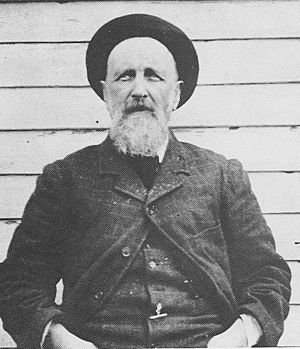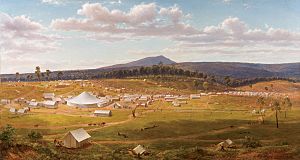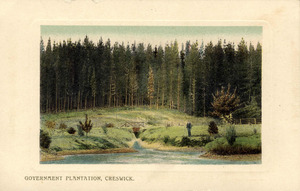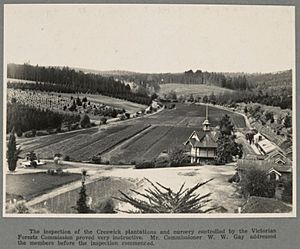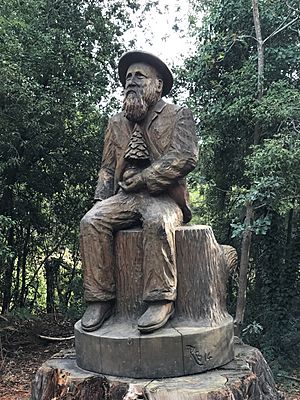John La Gerche facts for kids
John La Gerche was a very important forester who worked in the goldfields of Creswick, Australia, in the late 1800s. He helped protect and regrow forests that were damaged by gold mining.
Contents
John La Gerche's Early Life
John La Gerche was born on May 22, 1845, on the island of Jersey. He was the only son of Jean La Gerche and Marguerite La Mottee. His family name comes from the island's French history, and he likely spoke both French and English fluently. The La Gerche family were well-known farmers on Jersey. John's father was also a local police officer and a leader in the local army.
John grew up on a 14-acre farm that his family had owned since 1670. From 1857 to 1862, he went to Victoria College for boys. He was an excellent student, winning awards for his skills in languages like English, French, and German, as well as in mathematics.
In 1865, he traveled from London to Victoria, Australia, on a ship called the Agra. He arrived in Hobsons Bay near Melbourne on March 30, 1865. On the ship's list, he wrote his job as "gentleman." This suggests he came to Australia to start a farm or settle on land, rather than to search for gold.
Elizabeth Nora Bendixon, who was also from Jersey, moved to Australia in 1859 with her mother and four sisters. She worked as a housemaid for a rich family in Gisborne. John La Gerche and Elizabeth got married in Geelong on July 17, 1871.
Gold Rush Impact on Victoria's Forests
Before Europeans settled in Australia in the early 1800s, about 88% of the land that would become the State of Victoria was covered in trees. This was a huge amount of forest!
However, the Victorian gold rush of the 1850s changed everything. People cut down trees everywhere without much thought for mining, farming, and building towns. This was a major reason why so many forests were lost and damaged. Over the next 30 years, forests were quickly cleared to get wood for mining. This wood was used for things like supports in mines, planks, and firewood for steam engines. Forests were being cleared faster and faster around the goldfields. By 1873, it was thought that about 1,150 steam engines were used in gold mining, burning over a million tons of firewood!
During this time, managing the forests and enforcing rules was very messy. It was actually the huge need for timber by the mining industry, which made the colony rich, that finally made the government act. In 1862, Clement Hodgkinson, an assistant commissioner, set aside about 35,000 acres of forest near the goldfields. The forests around Creswick were protected later, in 1866.
In 1887, the Governor of Victoria, Lord Henry Brougham Loch, asked Frederick D'A. Vincent from the Imperial Forest Service in India to visit and give advice on managing Victoria's forests. Vincent wrote a very critical report, but it was never officially presented to the government.
It wasn't until June 14, 1888, that Victoria got its first official forest manager, George Samuel Perrin. He had experience from South Australia and Tasmania. Even though he didn't have much power, he was able to hire several foresters over the next 12 years.
John La Gerche's Sawmilling Business
In 1870, John La Gerche and his business partner, Dodd, ran a small sawmill in the Bullarook Forest (now called Wombat Forest). But their business ran into money problems and closed in 1875. They faced tough competition from other sawmills, and there weren't enough trees left to cut.
At that time, there were no clear rules for managing forests, which led to a lot of uncontrolled tree cutting. This likely made La Gerche realize that government controls weren't working well. In 1871, local Forest Boards were created to try and control the wasteful clearing, but it was a huge challenge. These boards only had three officers for the entire Wombat, Creswick, and Ballarat areas, which was an impossible task. The Forest Boards were eventually shut down in 1876.
By 1897, the entire Wombat State Forest was officially declared a "ruined forest" because of all the cutting. It's not clear what La Gerche did for the six years after his sawmill closed.
Crown Land Bailiff and Forester
In 1881, at 36 years old and with a growing family, La Gerche chose a more stable job as a timekeeper for the Public Works Department. Then, in October 1882, he was appointed as one of 16 Crown Lands Bailiffs and Foresters. These new jobs were meant to help stop the destruction of forests.
La Gerche's main job was to look after the Ballarat and Creswick State Forest. This area was almost a third the size of his home island of Jersey! His main goal was to stop people from illegally cutting timber. This was a very difficult job.
Foresters and Bailiffs had different uniforms and responsibilities. Bailiffs wore wide-brimmed hats and had authority over both Crown Lands and State Forests. Foresters wore smaller caps (La Gerche wore a beret) and only worked in State Forests. Only Bailiffs could take people to court, but La Gerche had both roles.
However, the rules for licensing timber were not very strict. Courts and judges often sided with the mining industry and woodcutters. La Gerche also had to deal with skilled lawyers who tried to get forest crime cases dismissed. It was hard to get people convicted unless he saw the illegal cutting himself.
It's said that La Gerche would ride his horse alone along the forest boundaries and sometimes stay overnight to guard the area. This way, he could hear axes cutting and follow the tracks of buggies illegally taking wood in the early morning fog. But the most successful illegal timber cutters simply avoided him, which was easy to do in the hilly forest. His hard work wasn't always supported by his bosses, and his methods made him unpopular locally.
It is also reported that La Gerche did not give in to pressure to remove Chinese workers from the forest.
Reforestation and Forest Repair
Part of John La Gerche's job was to grow new trees and fix the landscape damaged by mining. But he felt he couldn't do this until he stopped the illegal cutting. However, Vincent's critical report in 1887 was a turning point. After that, John La Gerche's job focused more on managing forests and plantations, and less on enforcing rules as a bailiff.
In 1887, La Gerche suggested that forest areas should be closed until the trees grew to a certain size. During this time, special permits could be given to cut small, crooked trees, leaving the healthy, straight young trees. Without any formal forestry training, La Gerche started a new experiment on 100 acres of Creswick forest. He removed small and crooked trees to help the healthy, straight ones grow better. He found that Messmate trees (Eucalyptus obliqua) grew well with this treatment.
John La Gerche was able to join Frederick D'A. Vincent during his visit to the Creswick forest in June 1887. Vincent later praised La Gerche's efforts to restore the forest.
La Gerche began the huge task of replanting the forest in 1883 by trying to grow blue gum seeds. The first seedlings didn't do well, but he didn't give up. He tried more experiments, growing Eucalyptus globulus, Eucalyptus camaldulensis, and Eucalyptus cladocalyx seedlings in the nursery in the late 1890s.
Sawpit Gully Nursery
Soon after starting his new job, La Gerche began repairing the damaged Creswick forest. A government nursery had been set up in Macedon in 1872 by William Ferguson, Victoria's first "Overseer of Forests." La Gerche worked closely with Macedon to get seedlings and advice.
In 1887, John La Gerche started a small plantation in Sawpit Gully, north of Creswick. He fenced off a 2-acre area and planted over 700 seedlings. La Gerche chose this spot because he was told its slopes and soil were "perfect for growing pines." The area had been heavily disturbed by old gold mining, but it had a water channel running through it. He set up a nursery there in 1888. The owner, Albert Wade, prepared the land for planting and agreed to be the caretaker.
By 1889, La Gerche had planted over 19,000 trees in the plantation areas near the nursery. With help from Albert Wade, a retired miner, the huge job of fencing, digging holes, and planting seedlings continued. Ten years later, in 1899, the plantation reached its largest size, covering 300 acres with 24,000 trees. However, the Creswick weather was tough on the first plantings, with low rainfall and harsh frosts.
Around 1889, about 100,000 seedlings grown at the Sawpit Gully nursery were moved to the abandoned New Australia Mine site, just north of Creswick.
Christopher Mudd, the forester in charge of the Ballarat Water Commission, also helped La Gerche by sharing seeds, plants, and ideas. From 1888, George Perrin, the Conservator of Forests, also took a special interest in the nursery and plantation. La Gerche was clever and got new trees and seedlings from anywhere he could find them, including some from the Ballarat Botanical Gardens. With Perrin's encouragement, new types of trees were introduced, such as planes, oaks, English maples, limes, several types of pines, sycamores, elms, and poplars.
In 1895, the government invited Inspector-General Berthold Ribbentrop, also from the Imperial Forest Service, to inspect Victoria's forests. He stated that "State forest conservancy and management are in an extraordinary backward state." Ribbentrop's report led to another Royal Commission, which started in 1897 and produced 14 reports before finishing in 1901.
By 1897, the year he left Creswick, nearly three-quarters of the forest had been thinned. Much of it was fenced, and many plantations were established. Gold mining was slowing down, and illegal timber cutting had almost stopped. The number of cattle in the forest had greatly decreased. La Gerche himself had personally planted over 100,000 seedlings.
Government departments often change. Between 1856 and 1907, the responsibility for managing Victoria's forests moved back and forth at least eleven times between three different government departments. The State Forest Department was finally created in 1908. La Gerche was appointed as one of its first Inspectors. The State Forests Department later became the Forests Commission Victoria in December 1918.
Later in 1908, La Gerche's original nursery was moved back to its current location further down the gully. This happened at the same time the Victorian School of Forestry opened.
John La Gerche's Legacy
John La Gerche passed away on November 18, 1914. He was buried with his wife Nora in the Ballaarat Old Cemetery.
La Gerche was mostly forgotten until the 1960s. That's when his detailed pocket notebooks were found at the Victorian School of Forestry (VSF) in Creswick. Later, in the 1980s, his letters were discovered in an old cupboard in the forest office in Melbourne.
A bushfire swept through much of the Creswick forest in February 1977, destroying many of the trees he had planted. However, it is still possible to find some parts of his original plantings.
In 1998, the La Gerche Trail was opened to remember his life and work. This walking trail was created by Ron Hateley, a senior lecturer from the nearby Forestry School, along with students from the University of Melbourne and the Victorian Landcare Centre. It is now managed by Parks Victoria.
A statue of John La Gerche can be found on the trail. It was carved in 2014 by the Creswick Railway Workshops Association from a fallen 112-year-old Sequoia sempervirens (Californian Redwood) tree. This tree is believed to have been planted in 1902 by La Gerche's successor, John Johnson.
In 2015, the Sawpit Gully area, including the nursery site and plantation, was given special heritage status.


